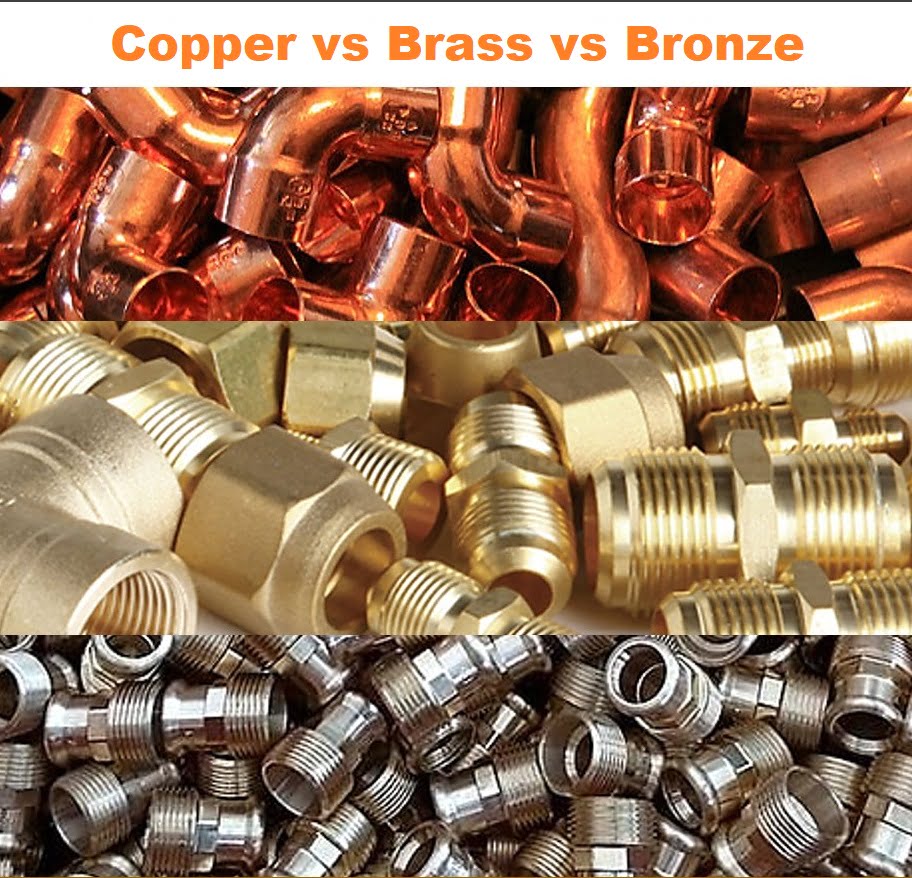구리 대 황동 대 청동: 종합적인 비교

구리, 황동 및 청동은 건축에서 전자 제품에 이르기까지 다양한 응용 분야에서 가장 중요하고 널리 사용되는 세 가지 금속입니다. 이러한 각 합금은 특정 용도에 적합하게 만드는 고유한 특성과 특성을 가지고 있습니다. 이러한 금속 간의 차이점을 이해하면 프로젝트에 적합한 재료를 선택하는 데 도움이 될 수 있습니다. 이 기사에서는 구리, 황동 및 청동의 구성, 특성, 장점 및 일반적인 응용 분야를 살펴봅니다.
1. 구성
구리
- 화학 기호: 구리
- 구상화 소둔 및 연화 처리: 구리는 원자번호 29번의 순금속입니다.
- 일반적인 합금: 구리는 아연, 주석, 니켈과 같은 원소와 합금되어 다양한 구리 합금을 만드는 경우가 많습니다.
놋쇠
- 화학 기호: CuZn
- 구상화 소둔 및 연화 처리: 황동은 주로 구리(일반적으로 55-95%)와 아연(5-45%)의 합금입니다.
- 일반적인 합금: 가공성이나 내식성과 같은 특정 특성을 향상시키기 위해 납, 주석 또는 알루미늄과 같은 기타 원소를 첨가할 수 있습니다.
청동
- 화학 기호: CuSn
- 구상화 소둔 및 연화 처리: 청동은 주로 구리와 주석(약 60-90% 구리와 10-40% 주석)의 합금입니다.
- 일반적인 합금: 알루미늄, 망간, 인 등의 기타 원소를 첨가하여 특정 특성을 향상시킬 수 있습니다.
2. 속성
구리
- 색상: 붉은빛이 도는 브라운 컬러입니다.
- 전도도: 전기 전도성, 열 전도성이 우수합니다.
- 내식성: 특히 해양 환경에서 부식에 대한 저항성이 우수합니다.
- 연성: 연성과 전성이 높아 광범위한 성형이 가능합니다.
- 힘: 강하지만 합금만큼 강하지는 않습니다.
놋쇠
- 색상: 노란빛이 도는 금빛 외관.
- 전도도: 전기 전도도는 좋지만 순수 구리만큼 높지는 않습니다.
- 내식성: 부식에 대한 저항성은 보통입니다. 녹청이 생길 수 있습니다.
- 연성: 연성은 양호하나 아연함량에 따라 차이가 있습니다.
- 힘: 일반적으로 순수 구리보다 강하며, 특히 고아연 합금에서는 더욱 그렇습니다.
청동
- 색상: 붉은빛이 도는 갈색이나 금색빛을 띠는 외관입니다.
- 전도도: 전기전도도는 좋으나 구리, 황동에 비해 낮습니다.
- 내식성: 특히 해수에서 내식성이 우수합니다. 황동만큼 쉽게 변색되지 않습니다.
- 연성: 구리만큼은 아니지만 연성이 보통입니다.
- 힘: 일반적으로 구리 및 황동보다 더 강하고 단단합니다. 특히 주석 함량이 높은 합금에서는 더욱 그렇습니다.
3. 장점
구리의 장점
- 전도도: 전도성이 높아 전기적 용도에 적합합니다.
- 내식성: 부식이 우려되는 환경에 유효합니다.
- 가단성: 다양한 형태로 쉽게 성형이 가능하여 다양한 제작이 가능합니다.
- 재활용성: 물성의 손실 없이 재활용성이 뛰어납니다.
황동의 장점
- 가공성: 구리에 비해 성질이 부드러워 가공이 용이합니다.
- 미적 매력: 외관이 미려하여 장식용으로 많이 사용됩니다.
- 항균 특성: 자연적으로 박테리아에 대한 저항력이 있어 배관 및 부속품에 적합합니다.
- 다재: 다양한 등급으로 제공되며 특정 용도에 맞게 맞춤화할 수 있습니다.
브론즈의 장점
- 내구성: 강도와 내마모성이 뛰어나 고하중 작업에 적합합니다.
- 내식성: 해양 환경에서 탁월한 성능을 발휘하며 조선 및 연안 응용 분야에 이상적입니다.
- 낮은 마찰: 마찰특성이 낮아 베어링, 부싱 등에 적합합니다.
- 논스파크: 폭발성 환경에서도 안전하게 사용할 수 있습니다.
4. 일반적인 응용
구리의 응용
- 전기 배선: 전도성이 우수하여 전기시스템에 널리 사용됩니다.
- 연관: 내식성이 우수하여 파이프 및 피팅류에 많이 사용됩니다.
- 전자제품: 회로기판, 커넥터 등에 사용됩니다.
- 지붕 이기: 심미성과 내구성이 좋아 건축용으로 사용됩니다.
황동의 응용
- 악기: 음향적 특성으로 인해 금관악기에 많이 사용됩니다.
- 피팅 및 밸브: 가공성이 좋아 배관, 난방 용도로 사용됩니다.
- 장식 아이템: 장식용 하드웨어 및 보석류에 자주 사용됩니다.
- 자동차 부품: 강도와 내구성이 우수하여 기어, 피팅, 부싱 등에 사용됩니다.
청동의 응용
- 해양 하드웨어: 내식성이 우수하여 보트 피팅, 프로펠러 등에 사용됩니다.
- 조각품 및 동상: 심미성과 내구성이 뛰어나 예술분야에 많이 사용됩니다.
- 베어링 및 부싱: 마찰이 적어 기계류에 활용됩니다.
- 역사적인 동전: 내구성과 내식성이 좋아 동전 주조에 사용됩니다.
5. 차이점 요약
| 재산 | 구리 | 놋쇠 | 청동 |
|---|---|---|---|
| 구상화 소둔 및 연화 처리 | 순수 구리 | 구리와 아연 | 구리와 주석 |
| 모습 | 적갈색 | 황색을 띠는 금 | 적갈색/금색 |
| 전도도 | 훌륭한 | 좋은 | 좋은 |
| 내식성 | 좋은 | 보통의 | 훌륭한 |
| 연성 | 고연성 | 좋은 | 공정한 |
| 힘 | 강한 | 일반적으로 더 강함 | 더 강하게 |
| 가공성 | 보통의 | 높은 | 보통의 |
| 일반적인 용도 | 전기, 배관 | 뮤지컬, 피팅 | 해양, 베어링 |
6. 결론
구리, 황동, 청동은 다양한 용도에 맞는 고유한 특성을 지닌 필수 재료입니다. 구리는 전기 전도성과 내식성이 뛰어나 전기 및 배관 응용 분야에 이상적입니다. 황동은 가공성이 뛰어나고 미적인 매력이 있어 장식용 악기와 악기에 자주 사용됩니다. 청동은 특히 해양 환경에서 내구성과 탁월한 내식성을 제공합니다.
올바른 재료를 선택하는 것은 강도, 내식성, 외관, 기계 가공성을 포함한 응용 분야의 특정 요구 사항에 따라 달라집니다. 구리, 황동, 청동의 고유한 특성을 이해하면 엔지니어링, 건설 및 예술적 노력에 대한 현명한 결정을 내릴 수 있습니다. 이들 금속은 각각 고유한 장점을 갖고 있어 현대 세계에서 없어서는 안될 금속입니다.
